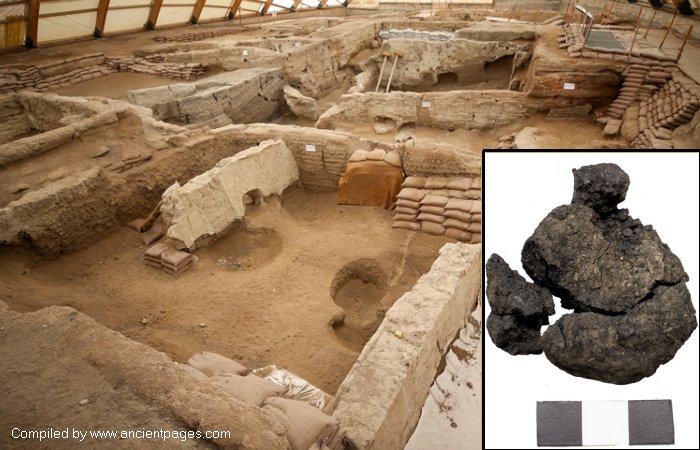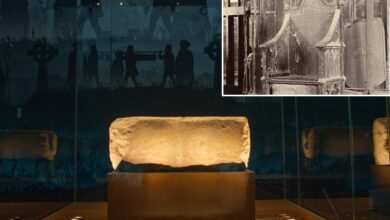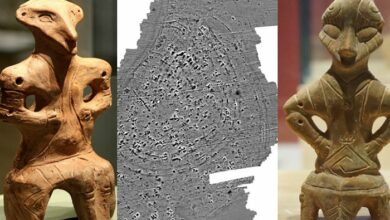World’s Oldest Bread Found In Neolithic Oven In Çatalhöyük, Turkey

Jan Baretk – AncientPages.com – While excavating in the Neolithic city of Çatalhöyük in central Anatolia, archaeologists found an 8,600-year-old piece of bread in a structure resembling an oven.
Located in the Cumra district of Konya, the ancient city was inhabited from about 7100 to 5950 B.C., with 3,500 to 8,000 people at its peak. Çatalhöyük is a significant archaeological site offering valuable insights into the shift from settled villages to urban conglomerations. This transition interestingly took place in the same spot for over 2,000 years.
The excavation site in Çatalhöyük. Credit: Science and Technology Research and Application Center (BITAM) of Necmettin Erbakan University in Konya
The Anadolu Agency (AA) reports the Neolithic oven was discovered in a region referred to as “Space 66,” which is notable for its adobe houses with interconnected roofs that are accessible from above. In close proximity to the significantly deteriorated oven, an artifact of palm-size was unearthed. This artifact contained seeds of wheat, barley, and peas, suggesting it was likely used for food preparation or storage.
The history of bread goes very far back in time. Bread has been known for millennia though its authentic history is lost in time. It is the primary food of man in almost all cultures worldwide.
According to Ali Umut Turkcan, Head of the Excavation Team at Anadolu University, this finding in Catalhoyuk is the world’s oldest bread.
Through careful examination, the researcher determined that the tiny, round, soft object discovered in the corner of the oven was actually bread. Its preservation can be attributed to a thin layer of clay that also protected wood and other organic materials from decay. After conducting radiocarbon tests at TUBITAK Marmara Research Center (MAM), the scientists found evidence suggesting the sample might date to around 6,600 BC.
“Considering observations, analyses, and dating, we estimate this organic residue to be approximately 8,600 years old.
It’s a miniature version of a loaf of bread. It hasn’t been baked in the oven but has fermented, preserving the starches. Such an example hasn’t existed until now. Catalhoyuk has always been the center of many firsts.
“Even in its early excavation years, the world’s first textiles were found here. Wooden artifacts were also discovered in Catalhoyuk. This adds to the wall paintings and drawings. In this regard, Konya and Türkiye are very fortunate,” Turkcan told the Anadolu Agency.
Turkcan also mentions that the earliest examples of leavened bread were found in Egypt. The ancient Egyptians are credited as being among the first civilizations to produce leavened bread. This historical fact is substantiated by various forms of evidence found in their art, such as paintings and reliefs depicting the bread-making process.
8,600-year-old pieces of leavened bread found in Çatalhöyük, Turkey. Credit: Science and Technology Research and Application Center (BITAM) of Necmettin Erbakan University
Lecturer at Gaziantep University Salih Kavak conveyed his enthusiasm for his significant contribution to the analysis and evaluation of the “Catalhoyuk Space 66 Neolithic Period Bread Discovery,” saying it was the most exciting study in archaeobotany to date.
Kavak told the Anadolu Agency that he first learned about the discovery while examining plant residues in his laboratory. The scientist was surprised when he received this information and initially questioned whether the discovered form could potentially be dough, bread, or some other type of organic residue.
The finding of fragmented or crushed components from plants such as barley, wheat, and peas significantly bolstered the likelihood that the substance in question could indeed be bread.
“Upon a visual morphological diagnosis and subsequent microscopic examination, the most exciting aspect was the presence of cereal residues.
Chemical analyses indicated signs of fermentation, suggesting the mixture had been prepared but not baked,” Kavak said.
See also: More Archaeology News
As reported by the AA, “Kavak concluded that this “unprecedented discovery” marks the oldest known bread-like specimen, sparking excitement in Türkiye and worldwide.” He also added that the “discovery of an 8,600-year-old bread residue at Çatalhöyük raised suspicions, which were confirmed through the analyses, indicating the sample’s unbaked nature.”
Written by Jan Bartek – AncientPages.com Staff Writer






